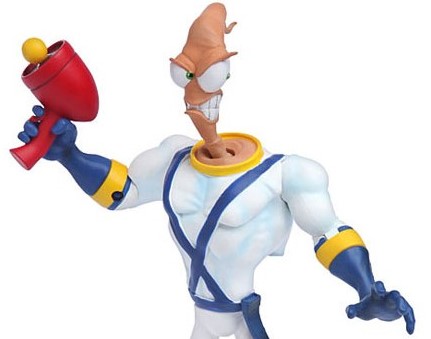
Earthworm Superheroes
STEMLinc Video Conferencing: Students are introduced to earthworms and the important role that they play. Students will investigate a number of interesting physical adaptations in the Australian earthworm species and use their findings to construct a blueprint of their own superhero earthworm. Students justify their design choices and reflect on how closely their design mimics real earthworms. (Image: Mezco Toyz Earthworm Jim)
Year Level Suitability: 3 – 4
Duration: 1 hour
STEM in a box:
You will receive a teacher guide with follow-up activities.
Background Information:
Earthworms might all look the same, but that’s because most people haven’t taken the time to get to know them. With thousands of species around the world, they come in many shapes and sizes. Victoria is lucky to have the biggest species in the world – the giant Gippsland earthworm. It can stretch up to 1-2 metres! In the Wet Tropics World Heritage area in north Queensland lives the Big Blue Earthworm.
Earthworms are happiest in moist soil, surrounded by dead plants. They are found in soil, leaf litter and under stones and logs in most habitats. They are most abundant in rainforests (wetter & heavily vegetated), but can survive in most places with damp soil.
Most earthworms only dig deep underground if they want to avoid a drought or a freeze. Otherwise they prefer the top metre or so of soil, which is full of decomposing leaves, roots and manure (which they love).
Native Australian earthworms are often eliminated by the clearing of natural vegetation, and many introduced species (primarily from Europe) dominate disturbed habitats, such as suburban gardens and farms.
Earthworms clean up decaying matter and turn it into glorious rich soil for plants to thrive in. They are nature’s best fertilisers, making nitrogen, potassium, sand and other substances usable by plants.
Prior Knowledge:
No prior knowledge is required.
Learning Intentions:
In this program students will:
- Discover the important role that earthworms play in the environment
- Investigate a number of physical adaptations in Australian earthworm species
- Use their findings to construct a blueprint of their own superhero earthworm
- Justify their design choices
- Reflect on how closely their design mimics real earthworms
- Discover how different parts to a worm’s body link with their functions
- Understand the meaning of the term decompose
- Learn the life cycle stages of earthworms
- Learn how they can identify and help earthworms in their backyard
Activities:
In this video conference students will:
- Observe various Australian earthworms including the Giant Gippsland earthworm
- Observe live earthworms under a microscope
- Identify and label the earthworm’s body parts on a diagram
- Draw & modify their own super earthworm either on an IPad (using Seesaw or Explain Everything app) or on paper or using plasticine (for tactile learners)
- Sing and move to the Worm song & Wonderful Wiggly Worms song
Victorian Curriculum:
Science – Science as a human endeavour
- Science knowledge helps people to understand the effects of their actions (VCSSU056)
Science – Biological sciences
- Living things can be grouped on the basis of observable features and can be distinguished from non-living things (VCSSU057)
- Different living things have different life cycles and depend on each other and the environment to survive (VCSSU058)
Design and Technologies – Creating Design Solutions
- Evaluate design ideas, processes and solutions based on criteria for success developed with guidance and including care for the environment and communities (VCDSCD031)
Critical and Creative Thinking – Questions and Possibilities
- Construct and use open and closed questions for different purposes (VCCCTQ010)
- Explore reactions to a given situation or problem and consider the effect of pre-established preferences (VCCCTQ011)
- Investigate different techniques to sort facts and extend known ideas to generate novel and imaginative ideas (VCCCTQ012)
Critical and Creative Thinking – Reasoning
- Identify and use ‘If, then…’ and ‘what if…’ reasoning (VCCCTR016)
Critical and Creative Thinking – Meta-cognition
- Consider concrete and pictorial models to facilitate thinking, including a range of visualisation strategies (VCCCTM018)
- Investigate a range of problem-solving strategies, including brainstorming, identifying, comparing and selecting options, and developing and testing hypotheses (VCCCTM020)
IMPORTANT: Cancellation Policy
-
-
- When you book you will receive an automated message from Eventbrite. Save this carefully please.
- Any cancellations need to be received in time for STEMLinc to re-sell your tickets to other teachers.
- Please use the Eventbrite confirmation email to facilitate any cancellation of your booking. That will automatically release your ticket for re-sale on our system.
-
| Date and Time | Ticket available | Booking link |
|---|
| Term | Lesson Date/time | Click to book (Note 1 ticket = a class of 25 students) |
| 1 | Feb 13th 10 am | Book here |
| 1 | Feb 13th 12 pm | Book here |
| 1 | Feb 13th 2 pm | Book here |
